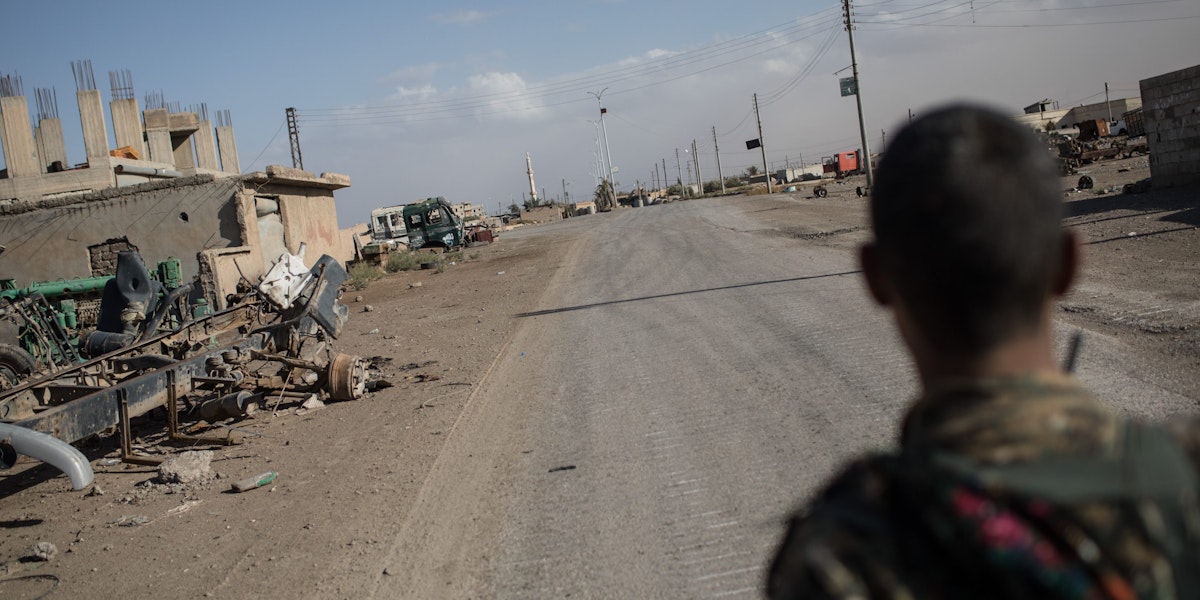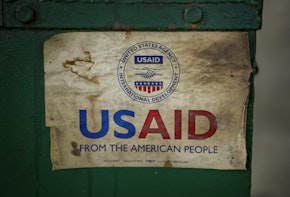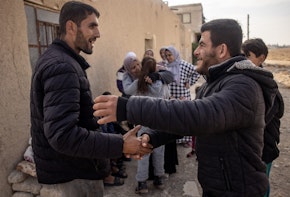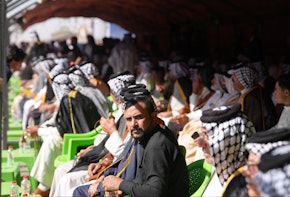The Syrian government is in the final stages of a military campaign to consolidate control of the country’s southern and central regions, and is already looking ahead to its post-war position. Despite the furor over alleged chemical weapons use by the government in April, and the retaliatory military strikes by the United States, United Kingdom, and France, the larger trajectory of the conflict remains unchanged. By retaking the armed opposition’s long-held enclave of eastern Ghouta in rural Damascus, Syrian president Bashar al-Assad cleared one of the final hurdles to full restoration. Beginning in August 2016 with the southern Damascene suburb of Darayya, the government’s ongoing strategy of siege-and-starve has given way to submit-or-die, and has seen neighborhood after neighborhood bombarded and “irreconcilables” forcibly displaced. As the rebels lose ground, any remaining residents fall back under Assad’s direct jurisdiction.
The Syrian government’s reconciliation policies have amounted to repeated war crimes, according to the Office of the High Commission for Human Rights (OHCHR);1 but the reduction in immediate conflict-related violence has raised the possibility for internally displaced persons (IDPs) and refugees to return to these so-called “post-reconciled” areas. This prospect, and the significant physical destruction caused by the fierce military campaigns, is fueling an ever-increasing debate within Western policy circles about how to fund, or whether to even engage in conversations about, stabilization and reconstruction in government-controlled areas of the country.
Unfortunately, having collectively failed to offer Syrians protection from these last seven years of violence, forced displacement, and exile, Western governments continue to pursue myopic priorities in Syria—thereby ensuring that the coming phases of the war, as well as what comes after, are run fully on Assad’s terms, causing even more suffering and injustice for Syrian civilians as they try to rebuild their lives and their country within his parameters. At this week’s Brussels II Syria Conference,2 in addition to pledging much-needed humanitarian aid funding, European leaders must address the growing suite of issues in government-controlled areas of the country and lay out their position on how best to realistically address them. Particular attention should be paid to work under the “humanitarian” umbrella that resembles reconstruction or development work, and careful consideration given to whether it is helping or hindering long-term stability.
Since the chemical weapons attack in Douma, both United States and French leadership have expressed the need to retain a long-term presence in Syria’s northeast as a bulwark against Assad’s total victory. However, even in these territories, stabilization work is slow and ineffective. President Trump has expressed reluctance to fund stabilization and reconstruction work in the northeast of the country, where the United States has a countering-ISIS military presence.3 Acting United States Assistant Secretary of State David Satterfield outlined the broader American policy on reconstruction to the Senate Foreign Relations Committee in January, stating that, “Until there is a credible political process that can lead to a government chosen by the Syrian people—without Assad at its helm—the United States and our allies will withhold reconstruction assistance to regime-held areas.”4A bill passed by the U.S. House of Representatives on April 24, if adopted, would see all U.S. funding to government-controlled areas of Syria halted until the government can demonstrate significant changes in behavior about conflict-violence and security concerns. In a practical sense, the current policy extends to the United States’ withholding of engagement on all issues of policy related to reconstruction in government areas. The United Kingdom, and the European Union too, currently remain steadfast in their decision not to fund reconstruction in government-controlled areas of the country before a peace process is agreed upon, though the European Union is engaging more extensively in government-controlled Syria through humanitarian aid, an increasing interest in the country from the EU’s development funding branch, and an increasing presence of diplomats, including last year’s appointment of a chargé d’affaires for Syria, Tosca Barucco.

Like previous failed Western policies in the war-torn country, the aim is an imagined “ideal.” The unspoken truth is that no one in the West is currently pursuing a trajectory out of Syria’s bloody war that will not include Assad—including through the posited UN-led election-process—thereby effectively leaving Assad to his own devices.
Perhaps it is, as others argue, most appropriate under such bleak circumstances for the West to walk away from Syria altogether; but this is neither likely, nor possible. America’s counter-terror concerns require the country to stabilize, and their desire to counter Iranian ascendancy in the region necessitates involvement of some kind. Meanwhile, Europe hopes to stem the flow of Syrian refugees, and even return them to their home country, and to allow their businesses to access lucrative reconstruction opportunities. Syria’s neighbors are growing increasingly frustrated with the burden they are carrying, and will likely become increasingly hostile to the millions of refugees that live within their borders, dependent on humanitarian aid to survive.
Given this landscape, there is both a moral and a political argument to be made for the United States, United Kingdom, and European Union to engage in reality-based, rights-up-front policy-setting that lays out their ambitions, and their bottom lines, beneath the current high-level positions related to a “political transition.” Western policymakers should familiarize themselves with the ways those ambitions are currently being undermined by Assad’s policies and practices, and work to change that outcome. If the behaviors cannot be changed, the West should withdraw from any and all processes or projects that are eroding long-term stability and peacebuilding in the country.
Which basic rights and legislative changes, extended to all Syrian people affected by the conflict, need to be enshrined in a political settlement, or constitution, for it to be deemed “credible” enough to Western powers for them feel comfortable releasing reconstruction funding? Why are these countries, who remain committed to a change of leadership, funding work that strengthens the capabilities of government line ministries and municipalities loyal to Assad? What conditionalities could be placed on current spending in the country to ensure it helps to improve or enshrine people’s basic rights as the country is rebuilt?
Even without challenging or changing the current policy of withholding funding for physical reconstruction, engaging in a rights-up-front approach to imagining stabilization, reconstruction, and refugee return is critical and urgent for three reasons:
- First, a political settlement that is palatable to the United States, as well as to other Western powers, is not forthcoming. While the West is still focused on the legitimacy, or otherwise, of Assad’s government, the current political process, which centers around an end to the violence, a new constitution, and elections, is unlikely to deliver a change of government or leadership, or to address issues of housing, land, and property (HLP) rights, reconstruction, and their impact on displacement and return. A document produced for the European Union in December last year highlights the danger in waiting until after a political process to tackle these problems, or tacking them onto a peace agreement as an annex, as was seen in the Dayton Agreement.5
- Second, the Syrian government will not wait for the political process. Assad and his ministries are rapidly creating and implementing a legislative and planning framework that ensures that reconstruction will take place on their terms, benefiting those it wishes to reward, and disempowering and permanently displacing those it wants to punish. Long-term post-conflict stabilization requires social reconstruction and the ability to repair the social fabric of a country as well as its physical structures, but the government’s current processes will exacerbate spoilers and undermine long-term stability or peace-building efforts within the country.
- Third and finally, well-meaning international organizations like the United Nations Development Program (UNDP), and other UN actors, are conducting reconstruction work in line with the government’s wishes, using Western funding. In doing so, there is a risk that the work will undermine the very humanitarian and rights-based goals that motivate these reconstruction efforts in the first place, thereby diminishing the chances of future stability and the possibility of exiled Syrians ever safely returning home.
Rebuilding Aleppo from the Ground Up: a Case Study
Focusing on Aleppo as a case study can usefully demonstrate the ways in which these factors of political transition and reconstruction are working in practice. Aleppo was the scene of one of the most entrenched front-lines of the war: from 2012 the city was stuck in a war of attrition, split almost in half between armed-opposition groups and the government, until a siege and months-long military campaign were waged against the eastern half of the city through the latter half of 2016. Prior to the siege, from 2014 onward, a fierce barrel-bombing campaign had been used by the Syrian air force to damage and destroy large areas of housing stock, and to force residents of the city’s eastern half to flee. The city’s pre-population of just under 3 million was depleted to a third of that, with nearly 2 million people currently displaced outside of the city, according to UN estimates in late 2017.
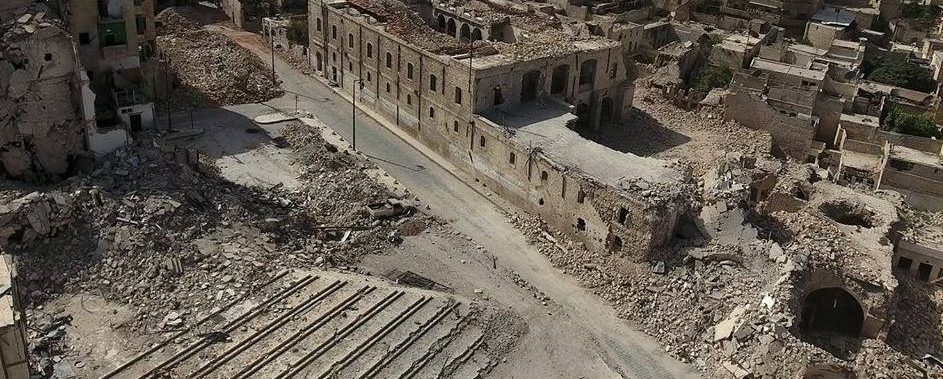
These years of war have seen 44 percent of the city’s housing stock, and 86 percent of commercial infrastructure, damaged, according to UN estimates in 2017. The majority of the damage is in the east, where most of the city’s informal housing—zoned as such in 2013 by the Regional Planning Commission6—is located. As a result, 87 percent of the city’s informal housing stock, as well, is now damaged. These areas of the city are most commonly where the city’s newer residents lived, in particular those who moved to Aleppo from rural areas in the pre-war period, and so were more likely to to be economically disadvantaged.7 In a recent interview, Hassan Jnaidan, head of the Syrian government’s Regional Planning Authority, highlighted that dealing with the issue of informal housing was the government’s top planning priority.8
In 2012, Decree 66, a critical piece of legislation dealing with informal housing, was passed into law. The legislation allows the government to redesign and permit redevelopment in these areas, with properties able to be purchased by developers at set rates, and evict the owners or residents without recourse. While the original bill was specific to rural Damascus, a January 2018 decision extended Decree 66 nationwide, meaning that all of Aleppo’s informal housing zones can be drafted into new developments and acquired at statutory rates. The move foreshadows the General Company for Engineering Consultancy (GCEC)’s long-anticipated Aleppo master planning process,9 which will tackle the future of the informal housing areas, as well as laying out broad development plans for the city as a whole and the industrial and commercial areas. A subsequent law—decree 10/2018, which has quickly become known as “law 10”—rewrites aspects of decree 66, and places even more powers over land zoning and development in the hands of the government,10 and is likely to be used in Aleppo, as well as other areas subject to “reconciliations” such as eastern Ghouta, to strip property from those seen as insubordinate.
Additionally, law 3/2018,11 passed in February, positioned as tackling the removal of rubble and classifying damaged buildings, actually has significant implications for people’s ability to maintain their HLP rights. The law states that a government committee will assess damaged buildings, then submit recommendations regarding the fate of the building, which will appear in a newspaper for fifteen days. The property owner then has thirty days to prove their ownership (likely in person, which presents a problem for those with security concerns), accept or dispute the decision, and collect their belongings and effects if the building is to be destroyed. After thirty days without successful claim, the property can be entered, the belongings and rubble sold, and the building demolished. If ownership is proven, the owner will receive a cash payment, upon receipt of which they forfeit further rights to the property or compensation.
A critical barrier for property owners seeking to claim compensation for damaged buildings is the fact that 77 percent of Aleppo’s damaged housing only has land records, with no official record of the building on the land. Government data indicate that up to 50 percent of land in Syria was not formally registered before the conflict began.12 Additionally, 33,000 ownership records in Aleppo were destroyed in the conflict. According to a 2017 study by the Norwegian Refugee Council (NRC) and the UNHCR, just 9 percent of refugees have their property title deeds with them in good condition, and nearly half of them said that their home had been destroyed or damaged beyond repair by the war.13
Currently, HLP interventions by international agencies fall into two categories. One type sees legal aid offered to IDPs and refugees, which highlights the need for them to retain or access their property records in the hope that this will assist them in laying claim to their property in the future.14 Within government-controlled areas, much of this work is being conducted by the Syria Trust, the NGO founded by Syria’s first lady Asma al-Assad. The other strand of work involves international agencies offering technical support directly to the government’s line ministries. The Regional Planning Commission is receiving support from the UNDP,15 and the UNHCR is providing technical and material support to the Ministry of Interior to enhance their capacity to provide HLP-related records.16 There is no indication in their documentation that the support extends further than simply building capacity. For the United States, and other Western donors, it is imperative that they ensure that this support is not serving to build these ministries’ ability to legally strip displaced Syrians of their properties.
Assad Calling the Shots
The Syrian government allocated 42 billion Syrian pounds for reconstruction in 2018 (around $82.5 million U.S.).17 This approved outlay cannot cover the whole cost of reconstructing the country. Assad’s relations with allies in foreign governments and the private sector, both domestically and abroad, have been wide-reaching as he attempts to coordinate the funds he needs. Public–private partnerships, such as those seen in the southern Damascus development areas, have yet to be formalized in eastern Aleppo around development projects, though these will likely quickly follow the release of the Aleppo Master Plan. In the meantime, the government is encouraging foreign investment, such as that from both public and private Iranian backers that have provided extensive funding for electricity infrastructure reconstruction in Aleppo,18 as well as for the reconstruction and repair of forty-seven schools and a handful of hospitals across the city.19 An Indian delegation accompanied the country’s ambassador in visiting the city in February to discuss reconstruction opportunities.20
Additionally, “stabilization” or “early-recovery” work, not to mention the ambiguously titled “refurbishment” work, is being carried out by UN departments and NGOs throughout the country, funded both multilaterally and bilaterally by international governments, but entirely in line with the Syrian government’s goals. For example, the Japanese government recently signed an agreement with the UNDP to provide $6 million for projects to refurbish power stations in Aleppo, as well as for livelihood programs.21 A key government priority is the rebuilding of the UNESCO heritage area in the Old City, including the Citadel and the Umayyad Mosque: these efforts are underway under the leadership of the Aga Khan Foundation with assistance from Italy22 and the German Technical Cooperation Agency.23
Work that falls under the humanitarian umbrella is also being directed by the government. When the UN’s “shelter cluster,” a collaborative working group of UN agencies and government departments led by the UNHCR and the government’s Ministry of Local Administration which focuses on housing needs, set priority areas, they began with the government’s listed priority neighborhoods, and overlaid the cluster’s priorities, then selected those that appeared on both lists. Of the eight areas selected, some did not fall within the east of the city at all. Areas of informal housing were not prioritized and will be dealt with through the government’s Aleppo Redevelopment Plan, during which time the powers contained in Decree 66 will likely be used to ensure that the residents of these areas cannot return, or lay claim, to their former homes.24
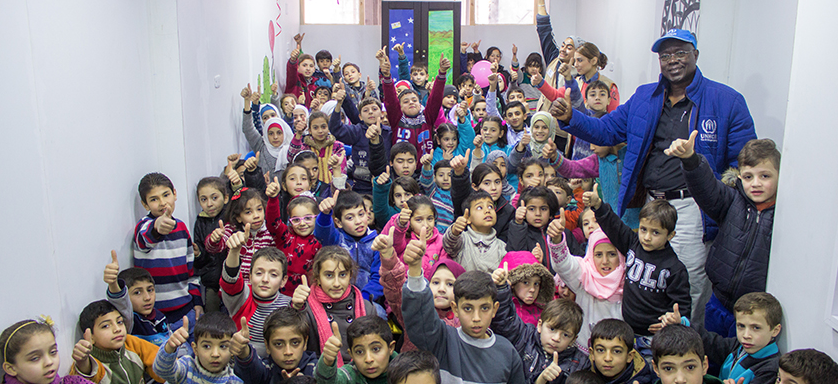
Three adjoining neighborhoods were chosen as a pilot area on which to focus resources, and into which to divert returning residents. However, government officials are reportedly prioritizing access to rehabilitation projects in these areas to those with freehold ownership records—namely those who can prove ownership of both the building and the land it sits on. The shelter cluster has also set frameworks for categorizing damaged buildings, using the heavily criticized model used in Homs—where reconstruction has been said to privilege those loyal to the government, and is likely to displace those who had properties in areas that supported the opposition—as the framework. Copies of the forms used to assess building damage bear the government’s logos, indicating that buildings marked for demolition will be subject to the conditions of law 3/2018.
The combination of these activities means that displaced persons from Aleppo could have their housing and property rights undermined through the very same reconstruction efforts that the UN and international agencies are involved in planning, and are actively implementing.
There have been signs that the UN may attempt to leave the widely criticized and regrettable practices they have displayed in the humanitarian aid program25 behind in the stabilization and reconstruction phases, in particular UN Secretary-General António Guterres’s commissioning of a policy paper in October of last year entitled “Parameters and Principles of UN Assistance in Syria.”26 The paper, which was finalized in January this year, would represent a significant change in the way the UN is operating in the country. After highlighting that reconstruction can only occur after a political settlement, it goes on to say that stabilization “assistance shall be determined consciously and explicitly without prejudice to the goals of accountability for serious human rights violations, and the goals of legitimate, equitable, and sustainable political settlement,” and says that agencies must prioritize these needs over Assad’s political ambitions. It must be said, however, that the paper applies only to development, stabilization, and reconstruction work, and does not relate to life-saving humanitarian aid—and that a political settlement is still the first condition for the UN’s engagement on these terms. Even with those caveats in mind, and despite the memo being disseminated in February this year, there is as yet no sign of the dramatic change in approach to policy implementation that the secretary-general’s request seems to promise.
What Options Are Left for the West?
If the West is to influence Syria’s postwar development, action must be taken before reconstruction gets into full swing: undoing or redirecting the Syrian government’s reconstruction plans once the laws have been passed, plans agreed on, building works begun, and individuals displaced will not be possible. Compared with the ideal of a democratic Syria, settling for some influence over reconstruction does seem like a stark compromise. But given that a change of government, or a political process that delivers a political change through elections, is impossible in any conceivable circumstance as the situation stands today, tinkering at the edges and attempting to influence even incremental shifts toward fairer outcomes for Syrians of all political persuasions is the best that can be done. Small shifts like these could be factored into constitution drafting, postwar political processes, and current humanitarian and development work that is ongoing in the country.
Even if these rights-based ambitions and policies are only imagined in relation to the national interest of each group—refugee return for European nations, long-term counter-terrorism ambitions for the United States—it is imperative to accept the current state of affairs. It is also critical to set out a framework for making changes and drawing red lines before states make pledges at the Brussels II conference.
It may be that a rights-based set of policy positions cannot be implemented, even incrementally, through either current Syrian politics or by demanding a new approach to development programming in the country from the outside. In that case, Western countries should withdraw funding and involvement until influence for those policy positions becomes possible, as Sam Heller and Thanassis Cambanis argued in their recent Century Foundation conversation.27
The Norwegian Refugee Council’s briefing at the recent Arab Land Conference in Dubai indentified HLP issues as ones currently being left to multiply in gravity until after both the war and a political settlement. If we wait until then it will be too late for most, and a lack of land or housing, and a wholesale disenfranchisement through redevelopment planning, will leave millions displaced in the long term, either abroad, or within the country, where they will remain dependent on long-term humanitarian funding to meet their basic needs. These concerns pre-date the war, have only become more pronounced throughout it, and will continue to be spoilers to long-term stability after it. The current situation, where solutions to these snowballing issues of property rights are being pushed into the long grass by those who are well placed to advocate on behalf of the rights of all Syrians, while day-to-day legal, planning, and reconstruction work by both the government and their allies, the Syrian and foreign private sectors, and international agencies working inside the country continues apace in accordance with Assad’s specifications, will simply mean that the already abhorrent injustices of the Syrian conflict will continue to destabilize the country and displace its citizens well into the future.
Notes
- “UN Commission of Inquiry on Syria: Despite tenuous progress on de-escalation in some locations in Syria, civilians continue to suffer from wide-ranging human rights violations and abuse,” Office of the United Nations High Commissioner for Human Rights, September 6, 2017, http://www.ohchr.org/EN/NewsEvents/Pages/DisplayNews.aspx?NewsID=22030.
- “Supporting the future of Syria and the region – Brussels conference, 24-25/04/2018,” European Council, Council of the European Union, conference agenda, http://www.consilium.europa.eu/en/meetings/international-ministerial-meetings/2018/04/24-25/.
- Tamer El-Ghobashy; “How American neglect imperils the victory over ISIS,” Washington Post, April 19, 2018, https://www.washingtonpost.com/graphics/2018/world/syria/raqqa-residents-abandoned-and-forgotten/?utm_term=.a7e380b531c3.
- David Satterfield; “U.S. Policy in Syria After ISIS: Testimony to the The Senate Foreign Relations Committee,” CSPAN, January 11, 2018, https://www.c-span.org/video/?439411-1/foreign-relations-panel-explores-us-policy-post-isis-syria.
- Produced for the European Union, “Urban Housing & the Question of Property Rights in Syria”, published October 2017, accessed 5 April 2018; https://drive.google.com/file/d/1bra99ucA6ElPQVj6p-wVlVxXdjThWh4B/view.
- “National Housing Map,” Regional Planning Commission, Syrian government, 2013, http://rpc.gov.sy/rpc2/wp-content/uploads/2013/07/National-Housing-map-indiscriminate.pdf.
- Kheder Khaddour, “Consumed by War: The End of Aleppo and Northern Syria’s Political Order”, Friedrich Ebert Stiftung, October, 2017; http://library.fes.de/pdf-files/iez/13783.pdf.
- Regional Planning Commission, “Eng. Hassan Jnaidan, head of the Regional Planning Authority in an interview with Sama satellite channel, talks about the importance of the role of regional planning in the reconstruction of Syria”, unknown date first published, accessed 21 March 2018, http://rpc.gov.sy/rpc2/.
- Prime Ministry website, “Prime Minister meets members of the People’s Assembly for the province of Aleppo“, 19 March 2018 published, accessed 22 March 2018, http://www.pministry.gov.sy/contents/13464/رئيس-مجلس-الوزراء-يلتقي-اعضاء-مجلس-الشعب-عن-محافظة-حلب-.
- Prime Ministry website, “Law no. 10 of 2018 stipulates that one or more regulatory zones may be established within the general organizational chart of the administrative units by decree upon the proposal of the Minister of Local Administration and Environment and the amendment of some articles of Legislative Decree No. 66 of 2012”, published 2 April 2018, accessed 5 April 2018; http://www.pministry.gov.sy/contents/13502/%D8%A7%D9%84%D9%82%D8%A7%D9%86%D9%88%D9%86-%D8%B1%D9%82%D9%85-/10/-%D9%84%D8%B9%D8%A7%D9%85-2018-%D8%A7%D9%84%D9%82%D8%A7%D8%B6%D9%8A-%D8%A8%D8%AC%D9%88%D8%A7%D8%B2-%D8%A5%D8%AD%D8%AF%D8%A7%D8%AB-%D9%85%D9%86%D8%B7%D9%82%D8%A9-%D8%AA%D9%86%D8%B8%D9%8A%D9%85%D9%8A%D8%A9-%D8%A3%D9%88-%D8%A3%D9%83%D8%AB%D8%B1-%D8%B6%D9%85%D9%86-%D8%A7%D9%84%D9%85%D8%AE%D8%B7%D8%B7-%D8%A7%D9%84%D8%AA%D9%86%D8%B8%D9%8A%D9%85%D9%8A-%D8%A7%D9%84%D8%B9%D8%A7%D9%85-%D9%84%D9%84%D9%88%D8%AD%D8%AF%D8%A7%D8%AA-%D8%A7%D9%84%D8%A5%D8%AF%D8%A7%D8%B1%D9%8A%D8%A9-%D9%88%D8%B0%D9%84%D9%83-%D8%A8%D9%85%D8%B1%D8%B3%D9%88%D9%85-%D8%A8%D9%86%D8%A7%D8%A1-%D8%B9%D9%84%D9%89-%D8%A7%D9%82%D8%AA%D8%B1%D8%A7%D8%AD-%D9%88%D8%B2%D9%8A%D8%B1-%D8%A7%D9%84%D8%A5%D8%AF%D8%A7%D8%B1%D8%A9-%D8%A7%D9%84%D9%85%D8%AD%D9%84%D9%8A%D8%A9-%D9%88%D8%A7%D9%84%D8%A8%D9%8A%D8%A6%D8%A9-%D9%88%D8%AA%D8%B9%D8%AF%D9%8A%D9%84-%D8%A8%D8%B9%D8%B6-%D9%85%D9%88%D8%A7%D8%AF-%D8%A7%D9%84%D9%85%D8%B1%D8%B3%D9%88%D9%85-%D8%A7%D9%84%D8%AA%D8%B4%D8%B1%D9%8A%D8%B9%D9%8A-%D8%B1%D9%82%D9%85-66-%D9%84%D8%B9%D8%A7%D9%85-2012.
- Prime Ministry website, “Law No. 3 of 2018 concerning the removal of the rubble of buildings damaged as a result of natural or abnormal causes or subject to the laws that require demolition’, 12 February 2018 published, accessed 10 March 2018; http://www.pministry.gov.sy/contents/13440/القانون-رقم-/3/-لعام-2018-الخاص-بإزالة-أنقاض-الأبنية-المتضررة-نتيجة-أسباب-طبيعية-أو-غير-طبيعية-أو-لخضوعها-للقوانين-التي-تقضي-بهدمها.
- Martin Clutterbuck, “”Property restitution in post-conflict Syria”, Forced Migration Review, accessed March, 2018, http://www.fmreview.org/fr/node/4833.html.
- Zweynert, Astrid Zweynert, “Syria faces 2 million lawsuits over lost and damaged property: experts”, Reuters, February 27, 2018,
https://www.reuters.com/article/us-syria-landrights-restitution/syria-faces-2-million-lawsuits-over-lost-and-damaged-property-experts-idUSKCN1GB300. - Laura Cunial, “Briefing Note: Housing, Land, and Property in the Syrian Arab Republic” Norwegian Refugee Council, May 2016; https://www.nrc.no/globalassets/pdf/reports/housing-land-and-property-hlp-in-the-syrian-arab-republic.pdf.
- Regional Planning Commission, “Regional planning technical support in collaboration with the United Nations Development Program (UNDP)”, unknown date published, accessed 22 March 2018; http://rpc.gov.sy/rpc2/%d9%85%d8%b4%d8%a7%d8%b1%d9%8a%d8%b9-%d8%a7%d9%84%d8%aa%d8%b9%d8%a7%d9%88%d9%86-%d8%a7%d9%84%d8%af%d9%88%d9%84%d9%8a/%d8%a7%d9%84%d8%af%d8%b9%d9%85-%d8%a7%d9%84%d9%81%d9%86%d9%8a-%d9%81%d9%8a-%d9%85%d8%ac%d8%a7%d9%84-%d8%a7%d9%84%d8%aa%d8%ae%d8%b7%d9%8a%d8%b7-%d8%a7%d9%84%d8%a5%d9%82%d9%84%d9%8a%d9%85%d9%8a-%d8%a8/.
- “Syria UN Strategic Framework/Year-End Review”, Fox News, 19 February 2017 published, accessed 21 March 2018; http://www.foxnews.com/world/interactive/2017/06/19/syria-un-strategic-frameworkyear-end-review.html.
- Prime Ministry website, “The Committee on Economic Policies and Programs adopts the Emergency Plan for Reconstruction of 2018 amounting to about 42.5 billion Syrian pounds“, published 15 March 2018, accessed 22 March 2018. http://www.pministry.gov.sy/contents/13462/لجنة-السياسات-والبرامج-الاقتصادية-تعتمد-الخطة-الاسعافية-لاعادة-الاعمار-للعام-2018-والبالغة-حوالي-5ر42-مليار-ليرة-سورية-.
- “Syria Signs Aleppo Power Plant Contract With Iran”, Voice of America, September 12, 2017, https://www.voanews.com/a/syria-signs-aleppo-power-plant-contract-with-iran/4025859.html.
- Martin Smith, “Bitter Rivals: Iran and Saudi Arabia”, Frontline PBS, February 27, 2018, https://www.pbs.org/wgbh/frontline/film/bitter-rivals-iran-and-saudi-arabia/#video-2.
- SANA, “India willing to contribute to rebuilding what has been destroyed by terrorism in Aleppo”, 28 February 2018; https://sana.sy/en/?p=128669.
- “UNDP and Japan boost support for resilience among communities in Syria”, United Nations Development Programme, February 6, 2018, http://www.arabstates.undp.org/content/rbas/en/home/presscenter/pressreleases/2018/undp-and-japan-boost-support-for-resilience-among-communities-in.html?platform=hootsuite.
- “Presenting the project for reconstruction of the suq, the Omayyad mosque and the minaret”, Palermo World, http://www.palermoworld.it/eng/presented-the-project-for-the-reconstruction-of-the-suq-the-omayyad-mosque-and-the-minaret/.
- Nabih Bulos, “Beyond Aleppo’s bustling market, the cost of Syria’s brutal civil war becomes clear”, LA Times, February 5, 2018, http://www.latimes.com/world/la-fg-aleppo-revival-20180205-story.html.
- Emma Beals, “UN allowing Assad government to take lead in rebuilding Aleppo, Fox News, November 27, 2017, http://www.foxnews.com/world/2017/11/16/un-allowing-assad-government-to-take-lead-in-rebuilding-aleppo.html.
- Nick Hopkins and Emma Beals, “UN pays tens of millions to Assad regime under Syria aid programme”, Guardian, August 29, 2016, https://www.theguardian.com/world/2016/aug/29/un-pays-tens-of-millions-to-assad-regime-syria-aid-programme-contracts.
- Emma Beals, “UN shelved 2017 reforms to Syria aid response,” IRIN, February 26, 2018, https://www.irinnews.org/feature/2018/02/26/exclusive-un-shelved-2017-reforms-syria-aid-response.
- Sam Heller and Thanassis Cambanis, “Managing Syrian Conflict May Be Possible. Resolving It Isn’t.”, The Century Foundation, February 12, 2018; https://tcf.org/content/report/managing-syrian-conflict-may-possible-resolving-isnt/.
